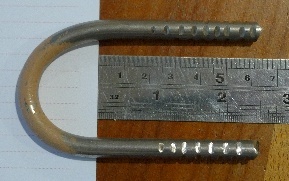- CCT Public Page
- [CCT Members Area]
I recently got asked a question about shortening the length of U-bolts when used in really hard rock like dolerite. This is based on the reply:
I'm REALLY glad you asked that question ... because I don't want to be clipping short U's!! ;)
So, the short answer is no; don't make them shorter. What follows is a longer answer to explain my thinking. It's bound to say lots of stuff you know already so apologies for that.
Firstly, reliability is a more important issue for glue-in anchors than average (or "expected") strength. So, controlling the rogue factors with adhesion are critical: the right glue; good mixing; good hole cleaning, enough notching, good cleaning (de-greasing) of the steel surfaces; reduction of air-pockets in the glue. That's why I've become something of a preacher on those issues!!
Reliability comes into the length question because length mitigates most of those issues (even if it doesn't eliminate them). So, you may be able to get enough strength in dolerite with 20 mm embedment but you've left no margin for things not being perfect - an air-pocket, or uncleaned dust, might tip it into the too-weak-to-work zone. Length also helps with imperfect rock (and lots of dolerite isn't perfect).
Moving on to some specifics about dimensions. The figure below illustrates the kind of U's I have made and which, I think, represents the dimensions of most U's in Tas (esp on dolerite and granite). I'm not sure, but I think these broad dimensions have also been used for Sand River? [I know OG and BM have; and I also hear the Stuart Scott et al have made them slightly longer, out of 215 mm rods].
Above: U made from 200 mm length of 316 stainless. Wood background shows embedment into the rock (50-60 mm*). Notches are ground into the last 45 mm of each leg. This provides at least 10 mm* of notch-free rod near the surface of the rock (to reduce risk of SSC corrosion).
* These dimensions vary due to irregularities when bending but the above spec guarantees at least 10 mm notch-free embedment and 50 mm total embedment.
Let's consider making it 10 mm "shorter". We would reduce both legs by 10 mm so we would make it out of 180 mm of rod (10% saving) and the holes have gone from 70 mm to 60 mm (14% saving). To preserve the 10 mm notch-free zone we would need to shorten the notched zone form 45 mm to 35 mm (22% shorter!!) which is starting to "feel" dodgy. Going to 20 mm shorter legs and we have a 20% steel saving but have lost nearly half our notched length! With modern drills it is easy enough to do the drilling, and the saved steel isn't worth much, so my view is that the economies aren't there.
The above begs the alternative question of whether Sand River U's should be LONGER? I have only done one route there but was surprised at how easy it was to drill the hole and how hard is was to clean it. My "feel" is that, so long as the holes are cleaned really well, that the "standard" U dimensions above are still OK. This is because it "feels" hard to conceive of a failure mode that doesn't take more than 7 kN to achieve (there is still a lot of either rock or glue that needs to fail). It would be nice to have that guess tested though. Nothing beats empiricism!
Overview
Content Tools

1 Comment
garry phillips
To add to Rogers post above I got asked the same question the other day as well.
All my u bolts are 200 to 220 mm long (even 270mm if required for soft rock) and the notching is 45 to 50mm long.
I believe the notches need to be wide (i.e. ground with a grinding wheel, NOT A CUTTING DISK ). That way the glue can get right into the notches.
These bolts have had a lot of testing with many falls (100s) taken on them in horizontal roofs with a straight down pull load as well as having had 3 to 4 adults swinging off them doing rescue training.
Clean holes, sufficient glue around the bolt and hole and obviously good rock is very important as well.
Also
While we are on the topic of this. A good way to strengthen a flake is to drill a hole through it and pin it with a pin (8mm rod or bigger). Make sure though that the rod is flush with the cliff or flake surface so it looks neat and you will not catch your hands on it.